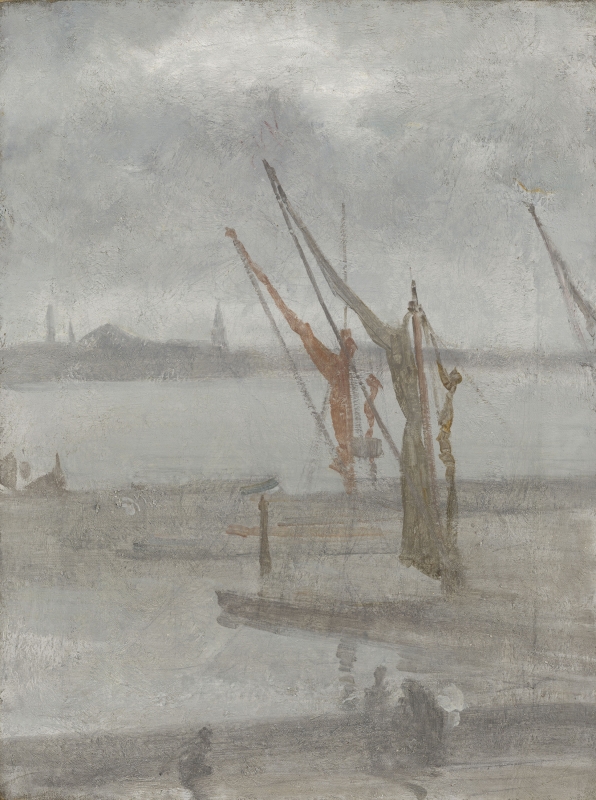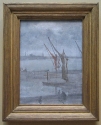Home > Catalogue > Browse > Grey and Silver: Chelsea Wharf << >>
Composition
The rather untidy technique, with layers of dryish paint criss-crossed haphazardly, suggests that it is concealing earlier compositions, although this is not, as yet, confirmed by X-ray analysis. There have certainly been later alterations to the masts, rigging and sails, which were finally painted with very thin paint over the uneven background when it had dried.
Technique
The canvas is a fairly fine weave. The size of the canvas corresponds with that of the French 'toile de 12' (46 x 61 cm) and it may have been acquired in France.
The painting is a subtle harmony of colours, cool greys enlivened by the rusty reddish-browns of the barges moored along Chelsea Wharf. The greys of sky and water were painted quite thickly, with distinct impasto near the edge of the water. In places, the grey shows through the more thinly painted additions of the figures, boats and sails.
As in Chelsea in Ice [YMSM 053] the wall of the Chelsea shore cuts across the foreground.
Conservation History
At the time of the retrospective at Goupil's in 1892 it was 'cleaned under my own supervision - and varnished.' 1
Frame
1865/1875: the style and whereabouts of the original frame are unknown. The first frame was removed during the Goupil Gallery exhibition preparations in 1892.
1892: Whistler wrote to the owner, J. G. Potter in March, saying,
‘I hope you are as pleased as I am with my new frames - at last the pictures have a dress worthy their own dignity and stateliness, Wherefore you may thank me for finally inventing them - You see it takes years to know these things - ...
I do trust you will keep the works in the frames I have put upon[ them - and so pay the little man Grau - You see I have only honours at present - and cannot afford to go round and remake the toilette of my pictures - but for the one who owns them, the sum must be of the smallest, and the advantage derived enormous - I say this because, - you would scarcely believe it - but I have met with something very like opposition, instead of gratitude, for the care I bestow upon my pictures even after they cease to be in my possession! - This however I know would not be the case with you - and indeed with the others they all ended by perceiving that the value of the works was greatly enhanced by this attention that I bestow upon them - Still there was a foolish rumour to the effect that you were opposed to all that I was doing for you!' 2
This appeal simply did not work, and Potter refused to pay for the work done by Grau. 3 Several years later, in 1894, Whistler wrote to E. G. Kennedy of Wunderlich's of this refusal : ‘Potter made a great fuss about paying for the cleaning and refused to take the one or two new frames I had put his paintings in … Mr Potter left the frames on my hands.' 4
However, it is possible that Potter actually left the Grau frames with D. C. Thomson at the Goupil Gallery, and he may have placed the same Grau frame back on the painting when he brokered its sale to the Peter A. B. Widener in 1895. Therefore this frame is one of three possibilities: it was made by Grau, or commissioned by Goupil following Grau’s pattern, or is an American-made frame similar to those made for E. G. Kennedy in New York. 5
Notes:
1: Whistler to J. G. Potter, [26/30 March 1892], #01488; see also [21 February 1894], GUW #05010.
2: Draft of letter, [26/30 March 1892], GUW #01488.
3: Goupil Gallery to Whistler, 20 May 1892, GUW #05740.
4: 4 February 1894, GUW #09715.
5: Dr Sarah L. Parkerson Day, Report on frames, 2017; see also Parkerson 2007 [more].
Last updated: 6th April 2022 by Grischka







